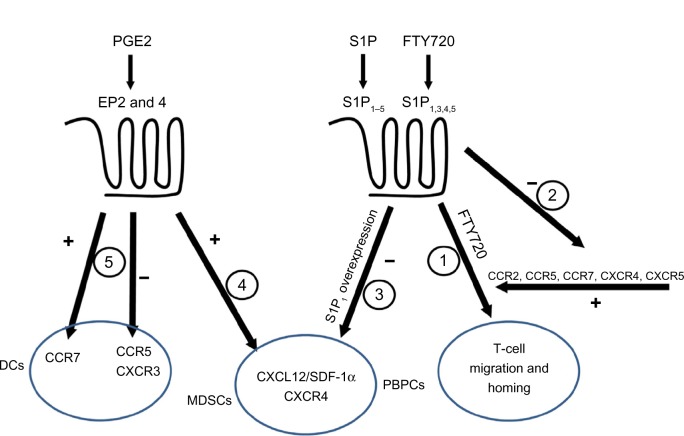Figure 2.
Interactions among chemokines and inflammatory lipids.
Notes: Both chemokines and inflammatory lipids receptors are coupled to G proteins. S1P1 binds S1P1–5, FTY720 binds S1P1,3,4,5, and PEG2 binds EP2 and EP4. Activity 1: CCR2, CCR5, and CCR7, as well as CXCR4 and CXCR5, contribute to the effect of FTY720-induced homing of lymphocytes. Activity 2: FTY720 through S1P receptor agonism reduced the expression of CCR1, CCR2, and CCR5 in renal parenchyma. Activity 3: Overexpression of S1P1 inhibits the migratory effect of CXCL12/SDF-1α for peripheral blood progenitor cells, and this effect is reduced upon FTY720 treatment due to downregulation of S1P1. Activity 4: The expression of CXCR4, as well as the secretion of CXCL12/SDF-1α, is increased by PGE2 on myeloid derived suppressor cells, leading to their recruitment into tumor growth sites. Activity 5: PGE2 is a prerequisite for the expression of CCR7 in monocyte derived DCs, and it enhances their migration towards lymph node associated chemokines CCL19/MIP-3β or CCL21/MIP-3α. However, the expression of CCR5 and CXCR3 in monocytes and macrophages is blocked, impeding natural killer cell-DC’s cross talk.
Abbreviations: PGE2, Prostaglandin E2; EP, prostaglandin E receptor; DCs, dendritic cells; CCR, CC chemokine receptor; CXCR, CXC chemokine receptor; SDF, stromal cell-derived factor; MDSCs, myeloid derived supressor cells; PBPCs, peripheral blood progenitor cells; S1P, sphingosine 1-phosphate.

